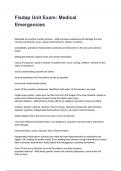Fisdap Unit Exam: Medical
Emergencies
Absorbed and surface contact poisons - ANS-corrosive substances will damage the skin,
mucous membranes, eyes, cause chemical burns, rashes, or lesions,.
acids/alkalis, petroleum (hydrocarbon) products are destructive to the skin and external
tissue.
distinguish between contact burns and contact absorption
history of exposure, liquid or powder on patient skin, burns, itching, irritation, redness of skin,
odors of substance.
avoid contaminating yourself and others
remove substance from the patient as fast as possible
remove all contaminated cothes
brush off dry powdery substances, flood/flush with water 15-20 minutes. use soap.
irrigate eyes quickly: make sure the fluid runs from the bridge of the nose outward, initiate on
scene and continue during transport; keep the patient eyes open.
abused inhalants - ANS-produce similar effects as sedative hypnotics. known as huffing.
acetone, toluene, xylenes, hexanes: found in glues, cleaning compounds, paint thinners,
lacquers, gasoline, halogenated hydrocarbons (freon), etc used in aerosol sprays.
briefly displace O2 in the brain and cause a rush of euphoria
very close effective and lethal dose, very dangerous. long term use can lead to permanent
brain damage.
mild drowsiness, coma, seizures, loss of brain function
halogenated hydrocarbon solvents can make the heart hypersensitive to adrenaline and
trigger v-fib, leading to cardiac death. Even walking may release enough adrenaline to cause
fatal ventricular dysrhythmia. Keep patient from struggling or exerting themselves.
Give O2 and use a stretcher to move the patient. promptly transport.
activated charcoal - ANS-binds specific toxins and prevents absorption, toxins leave the
body in stool.
,not indicated/ineffective with alkali, cyanide, ethanol, iron, lithium, methanol, mineral acids,
or organic solvent poisons.
if patient has decreased LOC or cannot protect their airway (no gag reflex), do not give
activated charcoal.
premixed suspension bottles usually contain up to 50g of activated charcoal.
usual dose for adult or child is 1g per kg of body weight.
Average in adults in 30-100g, average in children is 15-30g for children younger than age
13.
always obtain approval from medical control.
most effective if used within 1 hour of ingestion.
shake the bottle vigorously to mix the suspension after patient rights and medical control
looks like mud so cover it up, have patient drink with a straw
mix as needed to keep it suspended.
document any refusal
impacts include constipation, black stools, vomiting (after which dose has to be repeated),
be prepared for vomiting, nausea, and possible airway conditions
use a large plastic garbage bag to hang on the patient as a bib.
agitation - ANS-a behavior characterized by restless and irregular physical acitivity.
air embolism - ANS-the presence of air bubbles in the veins which can lead to cardiac arrest
if they enter the heart: most dangerous and common emergency in scuba diving
can occur in a dive as shallow as 6 feet (2 meters)
often when diver holds breath during rapid ascent and air pressure in the lungs remains high
while external pressure on the chest decreases, allowing air inside the lungs to expand
rapidly and alveoli to rupture. can cause:
pneumothorax, pneumomediastinum (space that contains the heart and great vessels), air in
the blood stream.
blotching (mottling of the skin), froth at nose and mouth, severe pain in
muscles/joints/abdomen, dyspnea, chest pain, dizziness, nausea, vomiting, dysphasia,
cough, cyanosis, difficulty with vision, paralysis and/or coma, irregular pulse and cardiac
arrest
, alcohol - ANS-can damage the liver
1/10 deaths in US adults is caused by excessive drinking
binge use has increased more than 17% since 2005.
CNS depressant -- a sedative and hypnotic
dulls awareness, slows reflexes, reduces reaction time; may cause aggressive and
inappropriate behavior, lack of coordination.
a person who appears intoxicated may have other medical problems. Look for signs of head
trauma, mental illness, toxic reactions, uncontrolled diabetes
severe acute alcohol consumption may cause hypoglycemia
assume all intoxicated patients have a drug overdose and transport immediately with ABC
support.
alcohol increases the effects of other drugs. OTC drugs (antihistamines, diet meds) can
cause serious complications when taken with alcohol.
beware of DTs
anticholinergic agents - ANS-medications that block parasympathetic nerves
OD: hot as a hare, blind as a bat, dry as a bone, red as a beet, mad as a hatter: -->
hyperthermia, dilated pupils, dry skin and membranes, reddened skin, agitation, delirium
atropine, antihistamines (diphenhydramine -- benadryl, datura stramonium -- jimson weed),
tricyclic antidepressants (amitriptyline -- elavil)
usually not abused except jimsonweed.
difficult to distinguish anticholinergic od vs sympathomimetic od -- both present with
agitation, tachycardia, and dilated pupils.
seizure and death from tricyclic antidepressant OD can occur within 30 minutes: transport
immediately. cardiac dysrhythmias are common
call ALS when en route.
anticholinergics - ANS-atropine, diphenhydramine, chloropheniramine, doxylamine, datura
stramonium (jimsonweed)
tachycardia, hyperthermia, hypertension, dilated pupils, dry skin and mucous membranes,
sedation, agitation, seizures, coma, delirium, decreased bowel sounds
Assessment of heat emergencies - ANS-LOC, ABCs, consider ALS (IV fluids, treat for
shock, etc)




